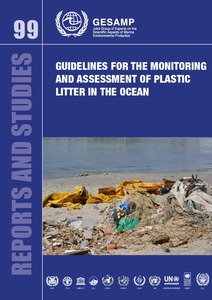| dc.contributor.editor | Kershaw, P.J. | |
| dc.contributor.editor | Turra, A | |
| dc.contributor.editor | Galgani, F. | |
| dc.date.accessioned | 2019-04-01T20:34:08Z | |
| dc.date.available | 2019-04-01T20:34:08Z | |
| dc.date.issued | 2019 | |
| dc.identifier.citation | GESAMP (2019) Guidelines for the monitoring and assessment of plastic litter and microplastics in the ocean (eds Kershaw P.J.,
Turra A. and Galgani F.), London, UK, GESAMP Joint Group of Experts on the Scientific Aspects of Marine Environmental Protection, 130pp. (GESAMP Reports and Studies, No. 99). DOI: http://dx.doi.org/10.25607/OBP-435 | en_US |
| dc.identifier.issn | 1020-4873 | |
| dc.identifier.uri | http://hdl.handle.net/11329/889 | |
| dc.identifier.uri | http://dx.doi.org/10.25607/OBP-435 | |
| dc.description.abstract | The Joint Group of Experts on the Scientific Aspects
of Marine Environmental Protection (GESAMP)
has been involved in the issue of marine plastic
litter and microplastics for over a decade. Initially
interest was focussed on microplastics, which were
considered as an emerging issue, and resulted in the
preparation of a scoping paper. This was followed
by an international workshop in 2010, organised by
GESAMP, on the subject of: Microplastic particles as
a vector in transporting persistent, bio-accumulating
and toxic substances in the ocean. This was one
of the first workshops that brought together
representatives of the chemicals industry, academia,
policy makers, intergovernmental organisations
and NGOs. It was hosted by IOC-UNESCO in Paris,
with additional financial support from the European
Commission. One of the conclusions of the workshop
was that further assessment of the potential impacts
of microplastics was warranted. This led to the
formation of GESAMP Working Group 40 (WG40)
in 2012: Sources, fate and effects of microplastics
in the marine environment. The first WG40 report
was published in 2015: Sources, fate and effects of
microplastics in the marine environment – a global
assessment. The second was published in 2016:
Sources, fate and effects of microplastics in the marine
environment – Part two of a global assessment.
It became apparent during the assessment, and
preparation of the reports, that there were relatively
few data available from monitoring programmes.
Most data that had been published were from
individual surveys or research projects, and there
was a lack of harmonisation of sampling methods
and attention to natural environmental variability.
This made the collation and comparison of data
problematic. At the same time, it was decided that
the artificial cut-off imposed by only focussing on
microplastics was inappropriate. Marine plastic litter
covers a wide spectrum of sizes, and larger items
tend to fragment to smaller particles. The title and
remit of WG40 was modified to reflect this more
inclusive approach.
An increasing number of administrations and
individual organisations have started to develop
routine monitoring programmes for marine litter
and microplastics, in response to greater political
and social awareness. Reliable monitoring allows
the setting of indicators and targets and supports
decision-making. The need for greater harmonisation
of methods has become more critical with the
adoption of the UN Sustainable Development Goals
(SDGs), in particular SDG14.1.1: floating plastic litter
as a global indicator of marine pollution. This need
has been recognised in resolutions passed by the UN
Environment Assembly (UNEA), with GESAMP being
considered an appropriate mechanism to develop
appropriate recommendations.
These Guidelines are the output of the third phase
of WG40. It is the product of a group of dedicated
independent scientists, supported by a number of
national and international bodies. They are intended to
provide practical guidelines and recommendations, in
particular to organisations that are less experienced
in marine environmental monitoring. As technologies
advance, and experience is gained, the Guidelines
may need to be revised. But for the moment we
hope the content of this report provides a helpful
contribution. | en_US |
| dc.language.iso | en | en_US |
| dc.publisher | GESAMP Joint Group of Experts on the Scientific Aspects of Marine Environmental Protection | en_US |
| dc.relation.ispartofseries | GESAMP Reports and Studies; 99 | |
| dc.subject.other | Marine litter | |
| dc.subject.other | Microplastics | |
| dc.subject.other | Mesoplastics | |
| dc.subject.other | Rapid assessment survey | |
| dc.subject.other | Marine pollution | |
| dc.subject.other | Marine debris | |
| dc.subject.other | Plastics | |
| dc.subject.other | Marine litter | |
| dc.subject.other | Plastic litter | |
| dc.title | Guidelines for the monitoring and assessment of plastic litter and microplastics in the ocean. | en_US |
| dc.type | Report | en_US |
| dc.description.status | Published | en_US |
| dc.format.pages | 130pp. | en_US |
| dc.contributor.corpauthor | GESAMP | en_US |
| dc.description.refereed | Refereed | en_US |
| dc.publisher.place | London, UK | en_US |
| dc.subject.parameterDiscipline | Parameter Discipline::Environment::Anthropogenic contamination | en_US |
| dc.description.currentstatus | Current | en_US |
| dc.description.sdg | 14.1.1 | en_US |
| dc.description.bptype | Best Practice | en_US |
| dc.description.bptype | Guide | en_US |
| obps.contact.contactemail | theoffice@gesamp.org | |
| obps.resourceurl.publisher | http://www.gesamp.org/publications/guidelines-for-the-monitoring-and-assessment-of-plastic-litter-in-the-ocean | en_US |
 Repository of community practices in Ocean Research, Applications and Data/Information Management
Repository of community practices in Ocean Research, Applications and Data/Information Management
